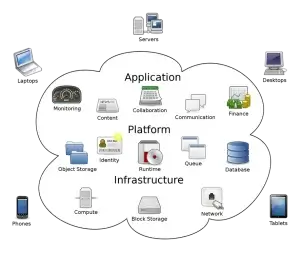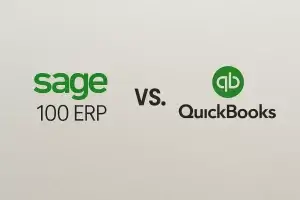QuickBooks has long been a financial management tool of choice among UAE businesses. However, when the companies start to grow, limitations in QuickBooks begin to emerge. As the scale of an organization grows, its operations naturally become more complex, and clearly, there is better that can be implemented.
That’s where Sage ERP comes designed to equip businesses with all-inclusive features that promote efficiency and growth. Following are 8 overwhelming reasons why the switch to Sage 100 ERP can be the turning point your company is looking for.
Why UAE Businesses Outgrow QuickBooks
1. Limited Scalability as Businesses Grow
QuickBooks was developed for small businesses and does not grow with your company. Therefore, businesses in the UAE that need to scale their operations, manage additional data, or introduce new processes find QuickBooks lacking.
On the other hand, Sage 100 ERP is developed to be highly scalable, easily adapting to your growing business needs solution considered among the best ERP software solutions in the UAE. The modular structure ensures businesses can grow without hindrances, hence an ideal solution for the UAE SMEs seeking flexibility.
2. Overuse of Spreadsheets and Workarounds
Most organizations in the UAE using QuickBooks use spreadsheets to manage those tasks that QuickBooks cannot handle, thus creating inefficiency and piling on the chances of errors.
Sage 100 ERP consolidates operations without manual tracking for more accurate and efficient data management. By removing the need to deal with spreadsheets, businesses can boost productivity while reducing errors and offering them better control over their businesses.
3. Inability to Cope with Increased Complexity
As businesses grow, so does the operational complexity. Inventory, financials, and customer data grow bulkier, with inefficiency ensuing in using QuickBooks. Sage 100 ERP lets you manage this complexity seamlessly to drive better decisions and operational efficiency.
It provides increased visibility across operations, delivering real-time data on inventory, financials, and customer relationships, making it much easier for businesses to stay on top of their growing needs.
8 Reasons to Upgrade to Sage 100 ERP
1. Deeper Insights to Make Wiser Choices
Sage 100 ERP offers each organization personalized dashboards, along with modern reporting. Companies in the UAE can analyze critical data in real time, optimize resources, and assess growth opportunities. By having deeper visibility, software-assisted businesses make wiser and more informed decisions so that they will be well-equipped in the competitive market.
2. Accounting You Can Rely On for Complex Requirements
Sage 100 ERP gets rid of spreadsheet inefficiency in fast-growing enterprises and delivers solid financial reporting. It offers proper reporting and compliance with the locals, especially in UAE, whose audit system largely relies on the preciseness of the finances. The real-time integration of financial data, thereby allowing businesses in the UAE to present complex accounting and auditing needs without a single mistake or error.
3. Scalability for Long-Term Growth
Sage 100 ERP architecture design allows organizations to select functions they require at any one time, ensuring ease of scaling, as perhaps necessary in future times. This provides the just-right mix of flexibility and scalability for UAE companies that want to look ahead to continued growth and effective operating cost control. As it’s able to scale with a company’s evolving needs, your ERP system will remain applicable and valuable as your business expands its future-proof ERP system.
4. Easier Migration from QuickBooks
Migration to Sage 100 ERP doesn’t have to lead to operational disruption. Quite a number of businesses across the UAE migrated from QuickBooks with negligible shutdowns.
An example could be one UAE-based company that transferred more than 2,000 customer records and open invoices into Sage 100 ERP without any data loss or operational shutdown. The system is designed to marry seamlessly with ongoing operations, making the changeover as bump-free as possible.
5. Customization and User-Friendly Design
Sage 100 ERP ensures that there is either role-based dashboarding or user-level personalization so employees will only see what pertains to them. This level of personalization simplifies workflows, increasing productivity, and thus helping UAE businesses be agile and efficient. The customizable dashboard allows the business to configure the ERP to their liking, which in turn enables each team member to focus on their work with whatever they may need.
6. Intuitive User Experience
Despite the high functionality, Sage 100 ERP is surprisingly easy to use. The intuitive nature of the software reduces the learning curve, making it easy for UAE-based teams to quickly take over and become productive to derive immediate value from the system. This intuitive design enables organizations to get the most out of their ERP right from day one.
7. Increased Visibility Across Operations
Sage 100 ERP allows for real-time and full enterprise visibility of inventory, financials, and operations across multiple locations to ensure effective usage, tracking of expenses, and well-thought-through decisions on its core operational areas.
Therefore, resource usage, management, and also operational control at every step may be optimized through the use of Sage 100 ERP to ensure resources are not overlooked in any operation.
8. Seamless Back-Office Operations
Sage 100 ERP puts CRM, e-commerce, and financial systems in one place to automate recurring tasks with no human errors. This not only enhances productivity but also allows UAE businesses to have full command over business operations by eliminating redundant processes. In other words, a business can effectively concentrate on its core activities to enhance its general effectiveness of operation through the smooth execution of back-office operations.
How to Make the Transition Smooth?
Partner with Local Experts
To make the transition smooth, work with experts who understand the Middle East market, especially in the UAE. They will help with bespoke advice on the implementation of Sage 100 ERP to ensure it is correctly and effectively deployed for your specific business needs. Businesses that partner with local experts can avoid the common pitfalls and ensure the implementation is as seamless as possible.
Extensive Training and Onboarding
Proper training is the key that unlocks the complete potential of Sage 100 ERP. The right training, backed by a skilled team, will ensure that the adaption is seamless and therefore lays the foundation for long-term success. Fully onboarding the employees ensures that they are capable of using the system effectively; this means increased productivity and less frustration.
Conclusion: The Smart Choice for Growing UAE Businesses
The transition to Sage 100 ERP from QuickBooks will completely redefine how growth and added complexity are managed within a UAE-based organization. Sage 100 ERP is designed for the progressive company that requires functionality to make running the business easier, supports informed decision-making, and keeps up with compliance demands. Ready to elevate your business?
Next step: Contact us today for a consultation or demo to learn more about how Sage 100 ERP can transform your business operations.



